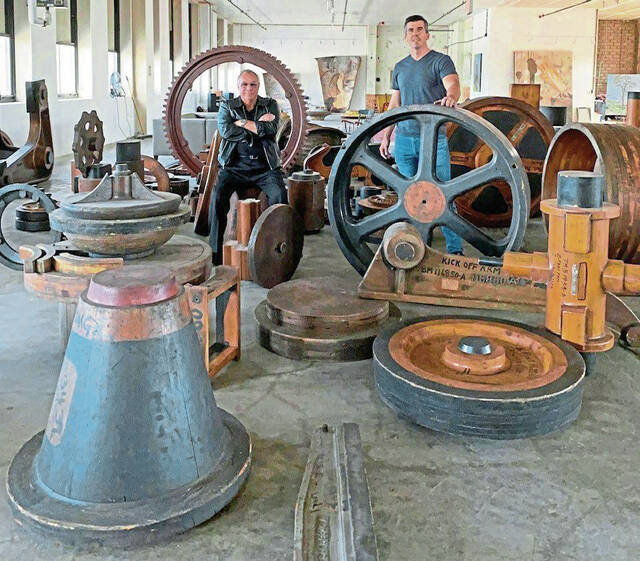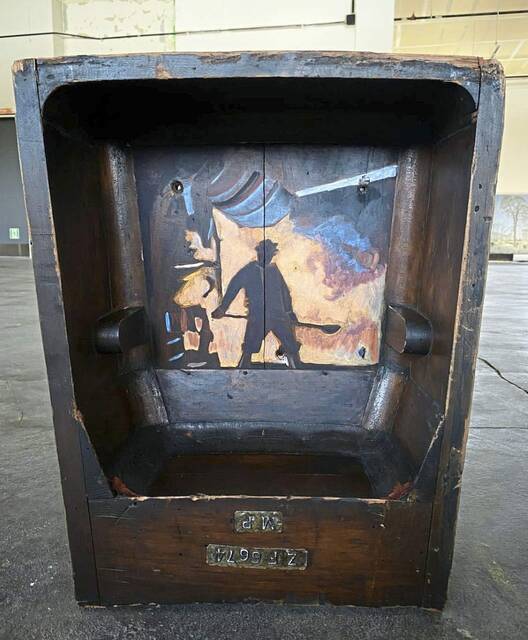Joseph Sabino Mistick: Pair's industrial art a love letter to steelworkers
An accidental discovery on social media led to a partnership between New Castle businessman Chip Barletto and Pittsburgh industrial artist Cory Bonnet, and, because of that, our community will always have permanent reminders of why we celebrate Labor Day.
Barletto has been visiting old steel mills for 50 years, starting when he was 10 years old, helping his father dismantle machinery for resale or salvage. Even then, he saw more in the machine pieces, wooden forms and technical drawings than just possible practical reuse.
“To me, even the smallest part was a work of art,” he says. “I still have the first piece I collected back then, a steam valve handle from an old pipe mill in Baden. It’s hanging in my office.”
As vice president of All Metals Recycling, Barletto visits old steel mills almost every day. Over decades, he has collected “hundreds and hundreds” of artifacts made by skilled industrial artisans. He ran out of wall space long ago.
So when Barletto saw Cory Bonnet’s industrial paintings on Facebook, he asked Bonnet if he might want to use some of these industrial pieces in his art, and offered him an old ladle pattern for starters. It is 14 feet tall, 8 feet across the top and 6 inches thick. On the concave surface of the wooden form, Bonnet painted a Bessemer converter pouring out molten steel.
When Barletto found a barn full of artifacts in Ohio, he asked Bonnet if he wanted to partner up, and the artist was all in. They spent days filling 10 box trucks, 26 feet long, with machine parts, wooden casting forms, gears and handles, all sorts of industrial wonders.
Much of their collection is on display at Bonnet’s studio at the Energy Innovation Center, the old Connelly Trade School in Pittsburgh’s Lower Hill District. Many of the pieces speak for themselves. They are unadorned, each one created for a specific industrial purpose. Others have become canvasses for Bonnet’s industrial scenes.
“I could tell that Cory was passionate about his art, and now he’s just as passionate as I am about preserving these things,” Barletto says.
Bonnet says, “This is how we can show our gratitude to those workers.”
Bonnet starts painting at 4 a.m. — the middle of what was “third trick” in the mills. He has time to ponder the wooden forms that were used to cast the necessary machine parts, and there is a lesson there.
“Each pattern is unique,” he says. “But they blend together to make something greater. Just like America.”
If you grew up here before the end of Big Steel, you know the stories. The grueling work, long hot days, noise so loud that you could hardly think when your life depended on thinking clearly, when the only thing that could cut the soot in your throat was a shot of cheap rye whiskey at the end of the shift.
That’s how it was when Labor Day started near the end of the 19th century. Thanks to labor unions, it’s different now. Mills are safer and cleaner, and the pay and benefits fit the work. For many Americans, Labor Day now is the end of summer and the start of school.
But the story of those workers who got us here comes alive in all those parts that they made with their own hands — parts they used to make machines that made steel that built a nation and defeated tyranny. For Chip Barletto and Cory Bonnet, this is their love letter to those workers.
Joseph Sabino Mistick can be reached at misticklaw@gmail.com.
Remove the ads from your TribLIVE reading experience but still support the journalists who create the content with TribLIVE Ad-Free.





